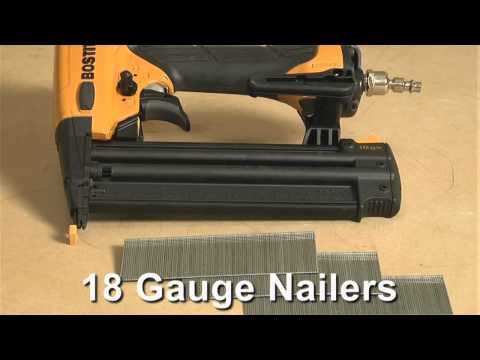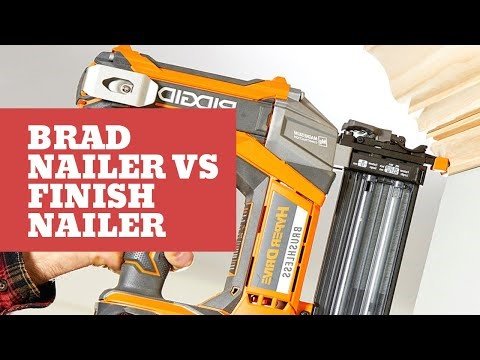Table of Contents Show
Brad nailers and finishing nailers are very similar on the surface (often called a finishing nail gun).
The two nailers are precise rather than mass nailing. However, all functions and uses are distinct.

Let us now compare the two styles of nail guns to each other.
What is a Brad Nailer?
A brad nailer looks and works like a nail gun. But unlike any other nailer on the market today, it does not actually fire nails. A brad “nailer” shoots brads.
For those that are unfamiliar with a brad nail, they are simply a thin nail. The typical brad nail has an 18 gauge nail and is usually just 0. 0475-inch cross-section.
As you can see, that is very small for a nail gun. Many inexperienced DIYers have most likely never used nails so tiny and thin.
What are the Advantages and Disadvantages of a Brad Nail Gun?
Advantages
- Brad nailer creates tiny holes. since the smaller nail is Limiting the possibility of your materials splitting or being damaged.
- They are incredibly light and compact.
- They only need one hand to carry them. This will make such tasks easier, such as nailing quarter round to a crown stapler project.
- They allow you to complete your project precisely and accurately.
- it is perfect for delicate trim and fragile materials, thanks to its small and precise structure.
You can position directly where you need to, and it will allow you to shoot the thin nail where you need it.
- they would work perfectly for attaching a baseboard.
- They are so straightforward to understand how it functions and operates.
Disadvantages
- The thinner bard nail cannot support large boards, heavy wood, or moldings.
- This is not the best tool for nailing in difficult-to-reach corners and tight spaces.
What is a Finish Nailer?
A finish nailer performs a similar function to a brad nailer. A finish nailer, like a brad nailer, would not be used for most of a job or project.
Instead, you only use it in very particular circumstances. A finish nailer, rather than a standard nail gun, will be used to fix trim or molding.
In terms of strength, a finish nailer lies somewhere in between brad nailers. And heavier-duty larger nail guns such as framing nailers.
Finish nailers are more powerful than brad nailers but not as powerful as a framing nail gun.
The typical finishing nailer can handle a bigger nail in terms of size, ranging from 1 inch to 2 1/2 inches in length.
What are the Advantages and Disadvantages of a Finish Nail Gun?
Advantaged
- 15-nail gauge and 16- nail gauge are larger and have more gripping power.
- Excellent for woodworking, furniture construction, repairing large baseboards. and plywood and affixing large crown molding.
- Finish nailers are more flexible and valuable for a variety of tasks.
- Corners can be reached with a 15-gauge nail gun collated at an angle.
Disadvantages
- The more oversized the nail, the larger the void that must be filled. For a carpenter, it means more effort filling the nail hole with wood putty.
- Poor option for fixing delicate trims and narrow boards.
What are the Differences Between a Brad Nailer and a Finish Nailer?
Size of the Hole
To begin, when used, they both leave different-sized holes in wood.
As every woodworker or carpenter will tell you, using a nail gun on wood always requires wood putty to cover the hole created by the nail gun.
This is important by using a finish nailer. A Finish nail hole also requires the use of putty to cover them. (though not as often as with the other nail guns).
Brad nailers, in general, do not leave a visible nail hole in the material.
If the material is particularly fragile or thin, it can leave holes. But you just need a small amount of putty to fill them.
Nail Gauges
The brad nailer is designed to fire an 18 gauge brad nail, while the finish nailer will fire either a 15 or a 16 gauge nail length.
To be more specific, the diameter of the smaller nail surface, the higher the gauge number.
Power
When we compare the two electric nailers, finishing nailers are the strongest and can handle heavy or thick trimming.
If you chose to be using a brad nailer for this scenario. Then you run the risk of the lightweight trim or crown molding falling off the wall.
The brad nailer is the best choice for light trims, such as creating a hole in the wall. And the finishing nailer’s strength would become a liability.
Uses
One of the main differences between the two is that brad nails will not break up or crack thin wood pieces. Another significant difference is how well each nailer handles corners.
Many carpenters tend to use brad nailers on corners because they do less harm than finish nailers.
Which is Better, a Brad Nailer or a Finish Nailer?
Choosing which nailer to use is heavily influenced by the density and volume of whatever you are working on.
When working with hardwood or thick plywood, it is best to use a finish nailer. At the same time, the brad nailer is better suited for light trims.
Most people would find a finish nailer to be more beneficial than a brad nailer. So, if you are trying to decide which one to get for your tool collection, I would go with the finish nailer.













